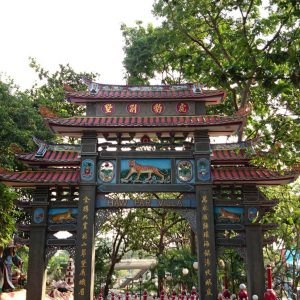Conscripting Chinese Diasporic Culture into National Identity: Taming of the Tiger Balm Gardens
March 14, 2022

Haw Par Villa is a heritage park containing statues from Chinese folklore. It was set up by brothers Aw Boon Haw and Aw Boon Par, who were also the founders of Tiger Balm. On 15 March 2019, tourism company The Original Singapore Walks began organizing night walking tours held every Friday at Haw Par Villa. This allowed visitors to see the park after dark and learn about death and the afterlife in Chinese folklore.
In the chapter ‘Conscripting Chinese Diasporic Culture into National Identity: Taming of the Tiger Balm Gardens’ from The Scripting of a National History: Singapore and Its Pasts (2008), co-authors Dr Lysa Hong (formerly NUS History) and Associate Professor Huang Jianli (NUS History) discuss how Haw Par Villa as a tourist attraction was altered to fit accordingly with the different national narratives of ‘Chineseness’ which Singapore had constructed over the years.
Haw Par Villa’s design was conceptualized by Aw Boon Haw, who instructed his artisans on its construction. Unsurprisingly, it served as a publicity space for the entrepreneur and philanthropist Aw’s Tiger Balm ointments, which were prominently displayed throughout the park, along with the tiger and leopard motifs that adorned the iron gates. The park was also a classroom where Aw taught uneducated Chinese coolies lessons on Chinese history, culture, folklore, and codes of morality. Chinese mythology was reflected in the statues within the park such as the Ten Courts of Hell, which portrayed the gruesome punishments that criminals went through in the afterlife.
After acquiring the park in the 1980s, the state favoured a more universal and traditional Chinese culture, instead of one associated with folk beliefs and practices of the Chinese immigrants. They aimed to upgrade Haw Par Villa to reflect this alignment and reproduce their conception of Chinese culture onto Singaporeans and tourists. In 1990, the park was renamed ‘Dragon World’. It was expanded and resembled an ‘Oriental Disneyland’ theme park, with boat rides and cultural performances. The developers emphasized, however, that it would also educate and impart Chinese values to its visitors apart from being a profit-driven Western theme park. Despite this, it was still criticized as being too Westernized because of the American music and American accents of the voice recordings used throughout the park. The local guides were also unable to adequately perform the cultural activities and performances, which meant that ‘native’ overseas Chinese had to be employed. The high entrance fees and low visitor numbers further contributed to the park’s eventual failure.
After further unsuccessful attempts to revamp Haw Par Villa, the state decided to bring the park back to its origins. It would not compete with the other modern tourist attractions but would remain a reflection of Aw’s private garden with Chinese mythological statues depicting Chinese folk heritage. This aligned with the state’s 2004 tourism slogan of ‘Uniquely Singapore’, where it tried to differentiate itself from mainland China and the rest of Asia. Instead of representing a universal form of Chinese culture, Haw Par Villa was to memorialize the specific culture of Singapore’s Chinese diaspora, celebrating their entrepreneurship and contributions to the state.
Get the book here.
